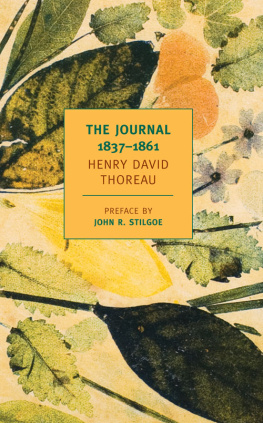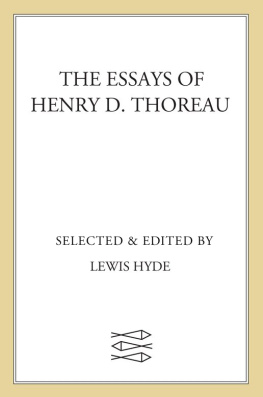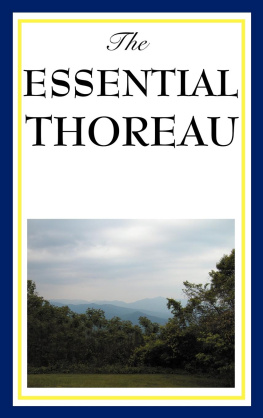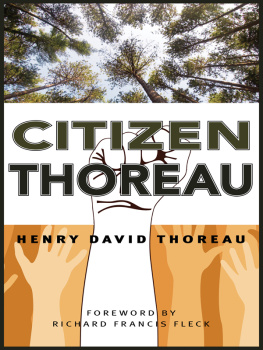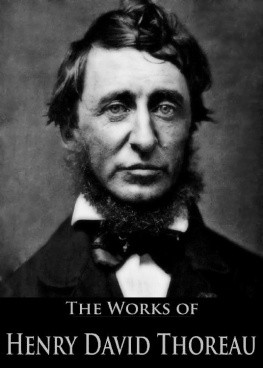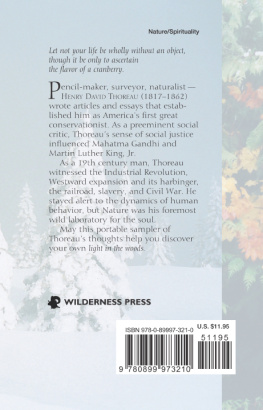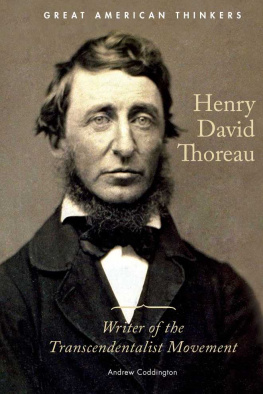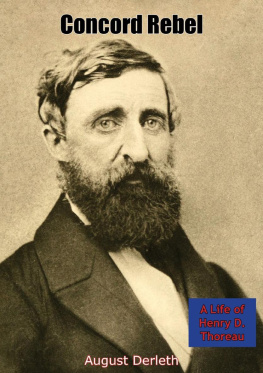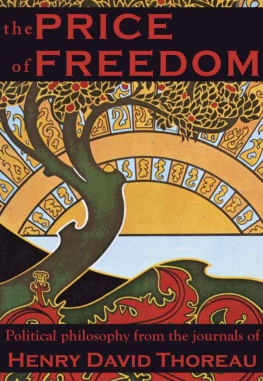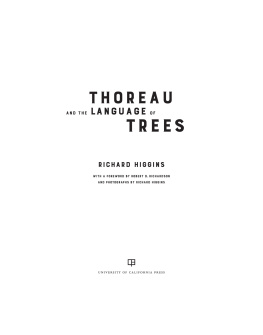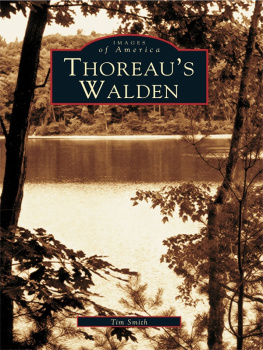thoreaus wildflowers

As the ice melts in the swamps I see the horn-shaped buds of the skunk cabbage, green with a bluish bloom, standing uninjured, ready to feel the influence of the sun. The most prepared for springto look atof any plant.
thoreaus wildflowers

HENRY DAVID THOREAU

Illustrated by Barry Moser
Edited by Geoff Wisner

Published with assistance from the foundation established in memory of James Wesley Cooper of the Class of 1895, Yale College.
Introduction and compilation copyright
2016 by Geoff Wisner.
Illustrations copyright 2016 by Barry Moser.
All rights reserved.
This book may not be reproduced, in whole or in part, including illustrations, in any form (beyond that copying permitted by Sections 107 and 108 of the US Copyright Law and except by reviewers for the public press), without written permission from the publishers.
Yale University Press books may be purchased in quantity for educational, business, or promotional use. For information, please e-mail (UK office).
Designed by Sonia Shannon.
Set in Adobe Garamond and Zapfino types by
Tseng Information Systems, Inc.
Printed in the United States of America.
Library of Congress Control Number: 2015953455
ISBN 978-0-300-21477-2
A catalogue record for this book is available from the
British Library.
This paper meets the requirements of ANSI/NISO
Z39.481992 (Permanence of Paper).
10 9 8 7 6 5 4 3 2 1
IN MEMORY OF
Professor Joel Porte, who started me on the path
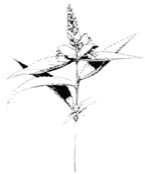
Contents
Preface
FOR MANY YEARS, Thoreaus self-appointed task was to roam the woodlands, meadows, and marshes of his native Concordobserving plants, animals, the weather, and his neighbors, then recording his observations in his Journal.
Beginning in 1850, the year Thoreau turned thirty-three, his botanical observations became more systematic. He began carrying plants home in his straw hat and pressing them for later study. He dated his Journal entries more consistently, noting when certain plants flowered and referring to them by their Latin names. He read his way through all the available botanical authorities and made it his goal to learn botanical taxonomy and to know every plant that grew in Concord, even the inconspicuous grasses and sedges that professional botanists often overlooked.
As his botanical expertise grew, so did his artistic sensibilities. By 1850, his two-year sojourn at Walden Pond was behind him, and he was engaged in the task of shaping his experience into a classic work of American mythology, a task that required seven distinct manuscript revisions and was not completed until 1854, when Walden; or, Life in the Woods was published. Thoreaus concern with the flowering plants of Concord, which lasted the decade or so that was left to him, was aesthetic, philosophical, and spiritual as much as it was scientific.
Thoreaus Wildflowers offers a generous selection of some of Thoreaus most evocative writings on the hundreds of flowering trees and plants that he knew, loved, and closely observed. It includes only a fraction of the record he left in his Journal. Each observation is arranged by the day of the year and presented in the context of the days weather, the presence of other plants and animals, and Thoreaus own mood and philosophical speculations.
The result is a panorama of the natural world that surrounded Thoreau, as it changed over the course of a year. More than an account of the natural history of Concord, this record is also an investigation of the spiritual significance of wildflowers for Thoreau, especially as they illustrate a central theme of his spiritual life: that of anticipation. The early buds Thoreau discovered in the winter were an implicit promise that spring and life would return. By attuning himself to the life around him, Thoreau found that he was able to anticipate not only the change of the seasons but the habits of the particular plants he sought.
In his consideration of wildflowers, Thoreau gave equal attention to the delicate blooms of herbaceous plants, trees, and grasses, including ghostly parasitic bloomers like Indian pipe and pinesap. He also recognized and responded to the flowerlike appearance of autumnal foliage, like the canopies of maples and scarlet oaks. For the purposes of this book, I have included passages that highlight both flowers and these flowerlike phenomena, with an emphasis on wild plants and on naturalized plants that, as Thoreau put it, have strayed into the woods from the cultivated stockincluding his beloved wild apples. Keeping my focus on the flora of Concord as it changes through the year, I have omitted plants that Thoreau observed on his excursions to Cape Cod, Maine, New Hampshire, Vermont, and beyond.
The more than two hundred black-and-white drawings that appear in this book were created by the renowned artist and illustrator Barry Moser. They first appeared as illustrations in Flowering Plants of Massachusetts by Vernon Ahmadjian, published by the University of Massachusetts Press in 1979. This was the first of dozens of books that Moser has illustrated in a long and honored career. These include The Pennyroyal Caxton Bible, the Arion Press edition of Moby-Dick, and the biographies Emerson: A Mind on Fire and Thoreau: A Life of the Mind by Robert D. Richardson. By allowing his work to be reprinted here, Moser has made possible an unprecedented pairing of botanical expertise with literary and artistic excellence.
Thoreaus Wildflowers will provide pleasure and insights to naturalists, gardeners, lovers of beauty, aspiring scientists, students of American literature, and Thoreau enthusiasts. Together with Thoreaus inspired yet detailed botanical observations and Barry Mosers illustrations, it offers an intimate portrait of Thoreau as Botanist by Ray Angelo, who is widely recognized as the leading authority on the flowering plants of Concord and on Thoreaus botanical record.
Acknowledgments
FOR THEIR HELP in the preparation of this book, I thank Gary Paul Nabhan, Marco Wilkinson, Stephen Stinehour, Kathy Crosby of the Brooklyn Botanic Garden library, and Jeffrey S. Cramer and Matthew Burne of the Thoreau Institute at Walden Woods. It has been a pleasure to work with the staff of Yale University Press, especially Jean Thomson Black, Samantha Ostrowski, and Laura Dooley.
Special thanks to Ray Angelo for allowing me to reprint his classic essay Thoreau as Botanist and to Barry Moser for agreeing to pair the words of Thoreau with his drawings of the flowering plants of Massachusetts. I am grateful to Cherrie Corey for an expert firsthand introduction to the plants of Great Meadows, for her helpful suggestions as the book was developing, and for her careful botanical review.
I thank Mike Frederick of the Thoreau Society for allowing me to present a preview of Thoreaus Wildflowers at the societys annual gathering in Concord. I am grateful for the warm welcome and offers of assistance I received from my copanelists Jym St. Pierre and Michiko Ono, and from presenters and attendees, including Mark Gallagher, Richard Higgins, Joe Moldenhauer, Nikita Pokrovsky, Audrey Raden, and Corinne Smith.
Next page

